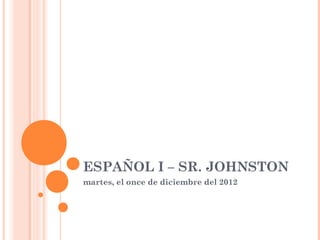
12 11 12 leccion
- 1. ESPAÑOL I – SR. JOHNSTON martes, el once de diciembre del 2012
- 2. Numbers 31–100 *notas Numbers 31–99 follow the same basic pattern as 21– 29. All rights reserved. Copyright © 2008 Vista Higher Learning. 2.4-2
- 3. *notas Y (and) is used in most numbers from 31 through 99. These numbers must be written as three separate words. All rights reserved. Copyright © 2008 Vista Higher Learning. 2.4-3
- 4. *notas With numbers that end in uno (31, 41, etc.), uno becomes un before a masculine noun and una before a feminine noun. All rights reserved. Copyright © 2008 Vista Higher Learning. 2.4-4
- 5. *notas Cien is used before nouns and in counting. All rights reserved. Copyright © 2008 Vista Higher Learning. Ciento is used for numbers over one hundred. 2.4-5
- 6. Copyright © 2008 Vista Higher Learning. 2.2-6 All rights reserved. *notas Question words
- 7. To ask a question that requires more than a yes or no answer, use an interrogative word. All rights reserved. Copyright © 2008 Vista Higher Learning. 2.2-7
- 8. When pronouncing this type of question, the pitch of your voice falls at the end of the sentence. All rights reserved. Copyright © 2008 Vista Higher Learning. 2.2-8
- 9. Notice the difference between ¿por qué?, which is written as two words and has an accent, and porque, which is written as one word without an All rights reserved. Copyright © 2008 Vista Higher Learning. accent. 2.2-9
- 10. In Spanish no can mean both no and not. Therefore, when answering a yes/no question in the negative, you need to use no twice. All rights reserved. Copyright © 2008 Vista Higher Learning. 2.2- 10